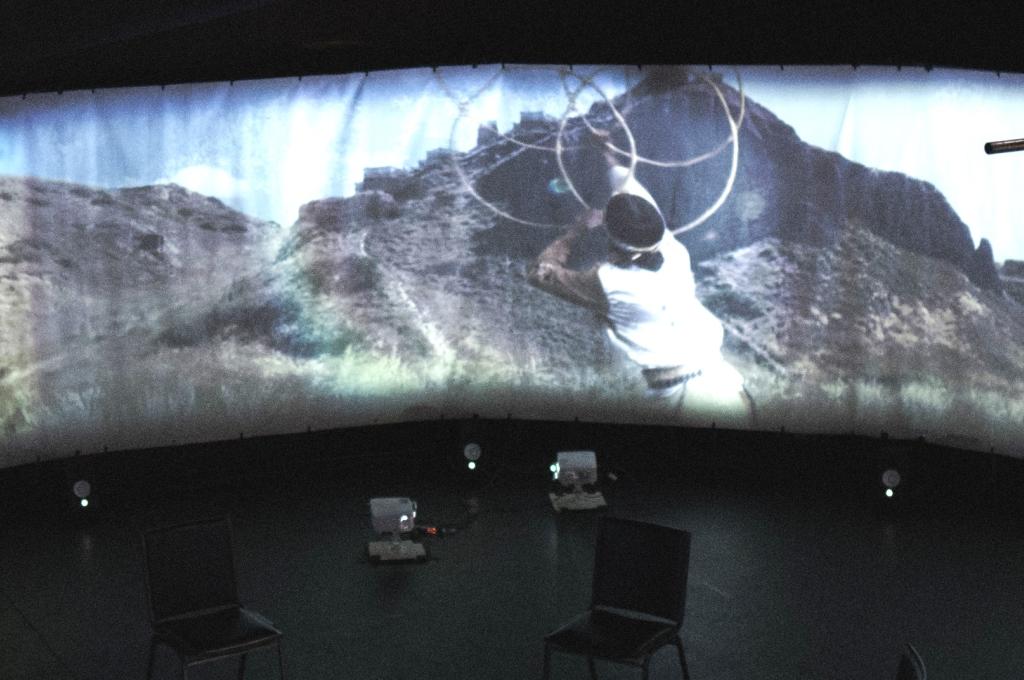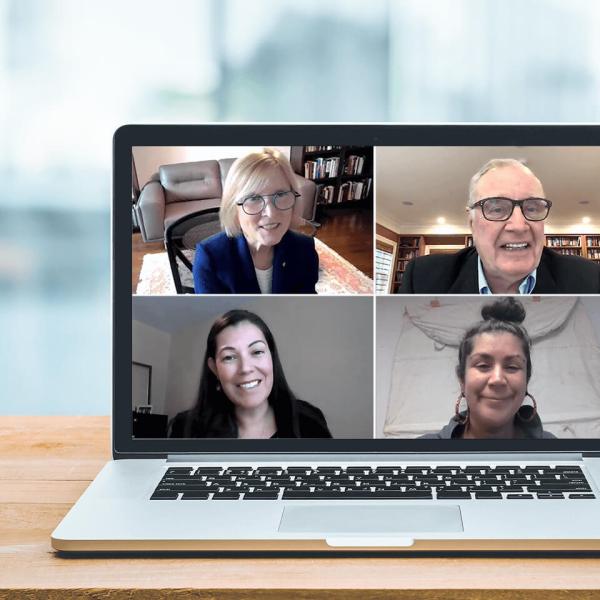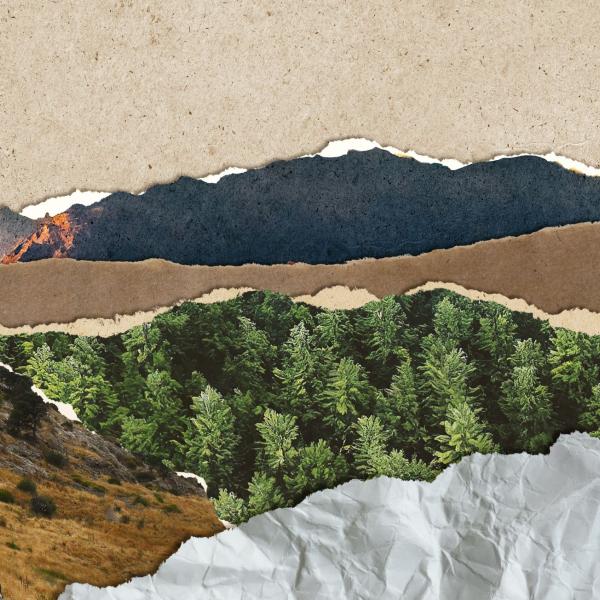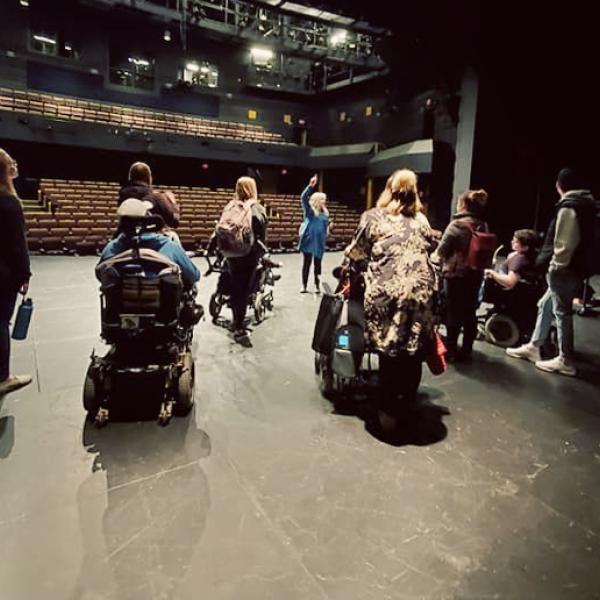Two years ago, Canada Research Chair Tékeniyáhsen Ohkwá:ri (Jackson Leween, 2bears) joined a group of Niitsitapi (Blackfoot) Elders on a trip to the British Museum in London, England, to photograph sacred, stolen warrior shirts, beadwork, quillwork and other items using photogrammetry.
The process, rendering digital models using real-world objects, involved shooting thousands of two-dimensional photographs of sacred Niitsitapi artifacts to create three-dimensional models. Due in part to the British Museum Act of 1963, stolen objects aren’t easily returned under colonial law, which prompted an idea — how can digital technologies be used to share Indigenous stories?
2bears is a Kanien'kehà:ka (Haudenosaunee) member of Six Nations of the Grand River (in Ontario), a cultural theorist, and a multimedia installation and performance artist; until 2023 he was Associate Professor in Indigenous Arts Research and Technology at the University of Lethbridge (U of L) in Lethbridge, Alta.
He has since moved to Western University in London, Ont., where he is associate professor of Visual Arts and Indigenous Studies, and Canada Research Chair (Tier 1) in Indigenous Arts Research & Technology. At Western, he is building a new CFI-funded laboratory called the Onkwehonwe Research Environment — a hybrid research-creation space dedicated to exploring how new and emergent technologies like virtual and augmented reality, artificial intelligence and other 3D environments can help protect Indigenous creative and cultural practices, and allow them to flourish.
Working out of the U of L’s CFI-funded Centre for Indigenous Arts Research and Transdisciplinary Praxis (CiART), 2bears used a mobile recording lab to explore creative practice and spatial storytelling in the digital age. Similarly, his new CFI-funded research space at Western will continue this mission by mobilizing new technology to support the innovation, transmission, expression and transformation of Onkwehonweha (a kanien’keha word for Indigenous ways of being).
Indigenous worldviews in a digital landscape
“Spatial storytelling is a term I borrowed from author and activist Vine Deloria Jr.,” 2bears says, “who proclaimed that there was an incommensurable difference between Tribal Knowledge and Western philosophical traditions. Whereas Western philosophy is temporal, a chronology unfolding linearly, Tribal Knowledge is spatial — it has dimension; you embody story, moving through a landscape you are traversing through our stories written on the earth.”
Indigenous worldviews are inherently land-based, embodied forms of Knowledge. In other words, spatial storytelling and teachings require participants to physically connect with a location to receive knowledge — you must experience and embody the space.
In the case of Niitsitapi Elders, teachings are inseparable from place and the Land — they are a shared, in-the-body experience. Given that sacred items are aspects of Indigenous teachings, what happens when they’re located somewhere else? How do Indigenous Peoples embody knowledge when places or sacred items are inaccessibly remote?
2bears’ research focuses on how digital landscapes and technologies can offer solutions.
Using photography, video, sound and virtual reality to create immersive experiences
“When we talk about stories, Land and our environments — our relations with living things in the universe — the idea is to create living virtual spaces,” says 2bears. “Our research has four areas: photogrammetry [three dimensional models from photographs], panoramic installations, virtual reality, and immersive ambisonic [full-sphere surround] audio.”
Panoramic installations are spherical structures participants step into to be immersed in 360 degrees of virtual reality and immersive audio. Picture a sphere covered in speakers, each representing an independent sound in a three-dimensional field. Step inside, and you’ll see and hear objects from every point of the sphere as you turn your head.
In a communal experience for members of Six Nations, 2bears shared the Haudenosaunee creation story in a panoramic installation, titled Ne:Kahwistará:ken Kanónhsa’kówa í:se Onkwehonwe. The installation blurred sound and space, creating a solution to accessing Indigenous Knowledge and meaning in the rapidly expanding, virtual landscape of digital Indigenous Territory.
2bears’ collaborator, Tsiothorkó:wa (January) Rogers, a Kanien’kehà:ka (Mohawk) and Tahskaró:ren (Tuscarora) artist and writer from Six Nations, worked with him on the installation.
“We’re incredibly grateful for the Centre for Indigenous Arts Research and Technology support,” says Rogers. “It was an ambitious project, made in collaboration with members of our Six Nations community. We made extensive use of digital media technologies to express Haudenosaunee creative and cultural practices.”
Speaking about how Elders respond to his research, 2bears lights up. “They love it. Every time we show them new technology — virtual reality or whatever — the response is always positive,” he says.
“When I speak to Elders in my community about artificial intelligence, for example, they get it right away. They completely understand because they have an expanded idea of life, inter-relational experiences, and other forms of intelligence in the universe. Artificial intelligence isn’t a big deal to them — it’s just another form, another entity we’re experiencing. So, they’re very excited.”
Protecting Indigenous communities and protocol
Indigenous relationships are built on nurturing trust, an ongoing process requiring protocol, procedure and sharing. A person can’t just walk up to an Indigenous Knowledge Keeper and ask them to share their teachings; there’s an entire process in Six Nations — and every Nation — across this Land.
“When I go home and do my work, I don’t just show up with equipment and start recording,” says 2bears. “There’s a lead-up involving feasts, conversations and enjoying the Land together, all based on Haudenosaunee cultural protocols. I consider myself accountable to my community and the responsibility that comes with that.”
Part of 2bears’ research is determining how to conduct protocol in a contemporary technological world. Smudging, praying, leaving tobacco when gathering in nature: he puts together a list of ways to conduct himself, building it directly into his art practice. For example, he practices protocol when recording bird sounds or taking photographs.
“It hadn’t occurred to me until about five years ago — why don’t I do any cultural practices when I take photographs, video or audio?” 2bears says. “When I was younger, I flew into the woods, shooting as many photographs as possible. Now, I take my time acknowledging the other creatures. If I’m doing any projection or sound-related work, I don’t disturb the wildlife in the area. I’m conscious and mindful about those activities and the forms they take.”
How Haudenosaunee identity and community influences practice
2bears says it might sound too romantic, but he can’t remember when he wasn’t interested in drawing, sketching or making music. It’s always been a deeply rooted part of his being and his most natural method of self-expression.
“I always tell my classes, ‘Haudenosaunee Peoples didn’t use the word ‘art’ before colonization,’” says 2bears. “There’s different taxonomy and context. Creative practices are embedded in our lives. We sing, drum, carve — it’s all part of our Haudenosaunee cultural life.”
“People often reduce the arts to therapy, methods of design, or aesthetics, but it’s about creating, in the way of not only being in the world but understanding the world, interpreting art through sensory experiences and translating it into emotions. It’s integral not only to Haudenosaunee epistemologies but to human epistemology: to knowledge itself.”
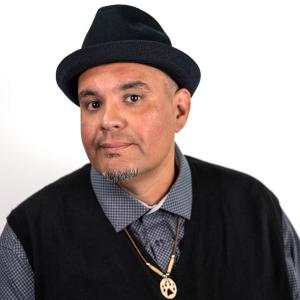
“We don’t think about Knowledge as something to possess; we think about it as a relationship. We are brought into a relationship understanding Knowledge has agency. ‘The Knowledge has me,’ rather than, ‘I have the Knowledge.’”
— Jackson Leween, 2bears


